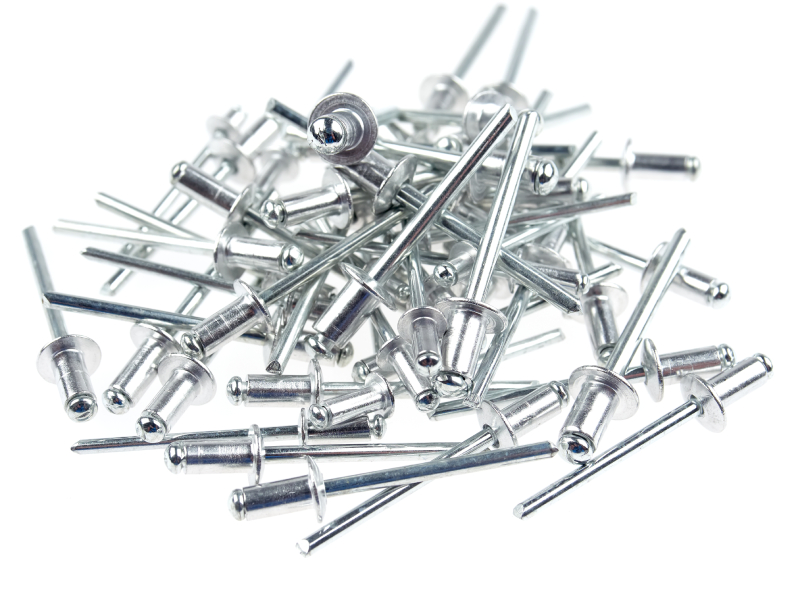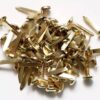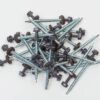Last Updated on June 14, 2023 by Marsh Fasteners
Blind rivets are also known as pop rivets. Together with blind riveting pliers or pop riveters, they are used to fix together materials when you have access to only one side. Think about attaching gutters to your house – you have access to only one side, so blind rivets are right for this job.
Once you have ascertained that blind rivets or pop rivets are what you need for the job at hand, you then need to figure out which type of rivet is best suited to your task
Stainless Steel Blind Rivets
Because these blind rivets are made of ISO 304 grade stainless steel, they provide a durable join. They are so good outdoors in the elements that they generally outlast the materials that are being joined. Use stainless steel blind rivets to attach license plates to cars or to repair rusty metal surfaces.
Waterproof Rivets
Waterproof blind rivets are manufactured in a single piece. This prevents leakage from taking place between the composite materials. Because of this, they are perfectly suited for the repair of gutters or assembly of shower panels, among other jobs.
High Performance Blind Rivets
High performance blind rivets are very useful in a variety of applications. Many contractors swear by these for jobs such as attaching signs and joining sheet materials.
Colored blind rivets
Colored blind rivets are ideal for jobs where you don’t want the rivet to be seen. You can get a color coded bind rivet that will hardly be noticeable when you attach number plates or accessories to your vehicle. These are the ideal rivets for color-sensitive projects and can be beautifully concealed.
XL blind rivets
XL blind rivets are great for joining soft materials like leather, rubber, or plastic with hard materials. They feature an extra-large head providing a bigger surface area for fastening and extra resistance.
Blind/Pop Rivets
Blind rivets, also known as pop rivets, are commonly used to quickly and securely join two or more pieces of material. They consist of a head and a hollow cylindrical pin called the body. The head of the rivet contains a mandrel, which is a long, thin pin with a depression in the middle. The mandrel serves as a stop at the other end of the body from the rivet head. Blind rivets come in various designs and can be made from different materials.
Standard Blind Rivet
One of the most popular types of blind rivets is the standard blind rivet. It is commonly used for metal-to-metal fastening and features a simple body and a dome-shaped head. The body of the rivet expands at its blind end when the mandrel is partially pulled through it, creating a second head that securely binds the materials together. Standard blind rivets find applications in automotive, construction, furniture, electrical appliances, etc.
Sealed Blind Rivet
Sealed blind rivets have a sealed end, with the mandrel head enclosed within the rivet body. This design prevents liquids from entering or exiting the rivet, making it suitable for metal-to-metal fastening in construction, automotive, furniture, and electrical appliances.
Peeled Blind Rivet
Peeled blind rivets have a larger bearing surface due to the increased diameter of the locking head. As the mandrel is pulled through the body, the sides of the rivet fold over, creating a head with a flower-like shape. Peeled blind rivets are ideal for joining metal to softer materials and find applications in construction, trailers, plastic parts, and upholstery.
Grooved Blind Rivet
Grooved blind rivets are designed for attaching softer materials like plastic and wood. When installing these materials, the grooves on the rivet's body provide enhanced holding power. Grooved rivets are commonly used for metal-to-wood and metal-to-building supply connections in construction, furniture production, and electrical equipment.
Multi-Grip Blind Rivets
Multi-grip blind rivets have indents on the body that enlarge when the mandrel is pulled into the rivet, providing multiple grips. They are suitable for joining plastic-to-plastic and metal-to-metal connections.
Soft Set Blind Rivets
Soft set blind rivets, also known as soft rivets, are made of softer metals like aluminum. They secure fragile materials without causing damage since the mandrel breaks off with less force than other rivets. Soft rivets can be used in buildings, furniture, packaging, and containers.
Other types of blind rivets include dome head blind rivets, large head blind rivets, and countersunk head blind rivets, each with its specific applications and advantages.
Blind rivets can be made from various metals, such as steel, stainless steel, aluminum, copper, and brass. The choice of material depends on the specific requirements of the application. Blind rivets are versatile fasteners used in various industries and applications, providing secure and reliable connections between different materials.
Choosing the right size of blind rivet
To ensure a proper fit, it's crucial to determine the grip range and select the appropriate length of the blind rivet. The grip range refers to the total thickness of the materials being joined together. Use the table below to determine the length of the blind rivet based on your measured grip range and the desired diameter of the blind rivet.
Example: If you have two metal plates with a grip range of 13 mm and want to use a 4.8 mm diameter blind rivet, the rivet must be 18 mm long.
For further information and assistance in choosing the correct blind rivet for your specific needs, contact the experts at Marsh Fasteners. We offer many fasteners, including nails, screws, nuts, bolts, and blind rivets. Our knowledgeable team can provide valuable guidance and help you find the most suitable fastener for your project.




